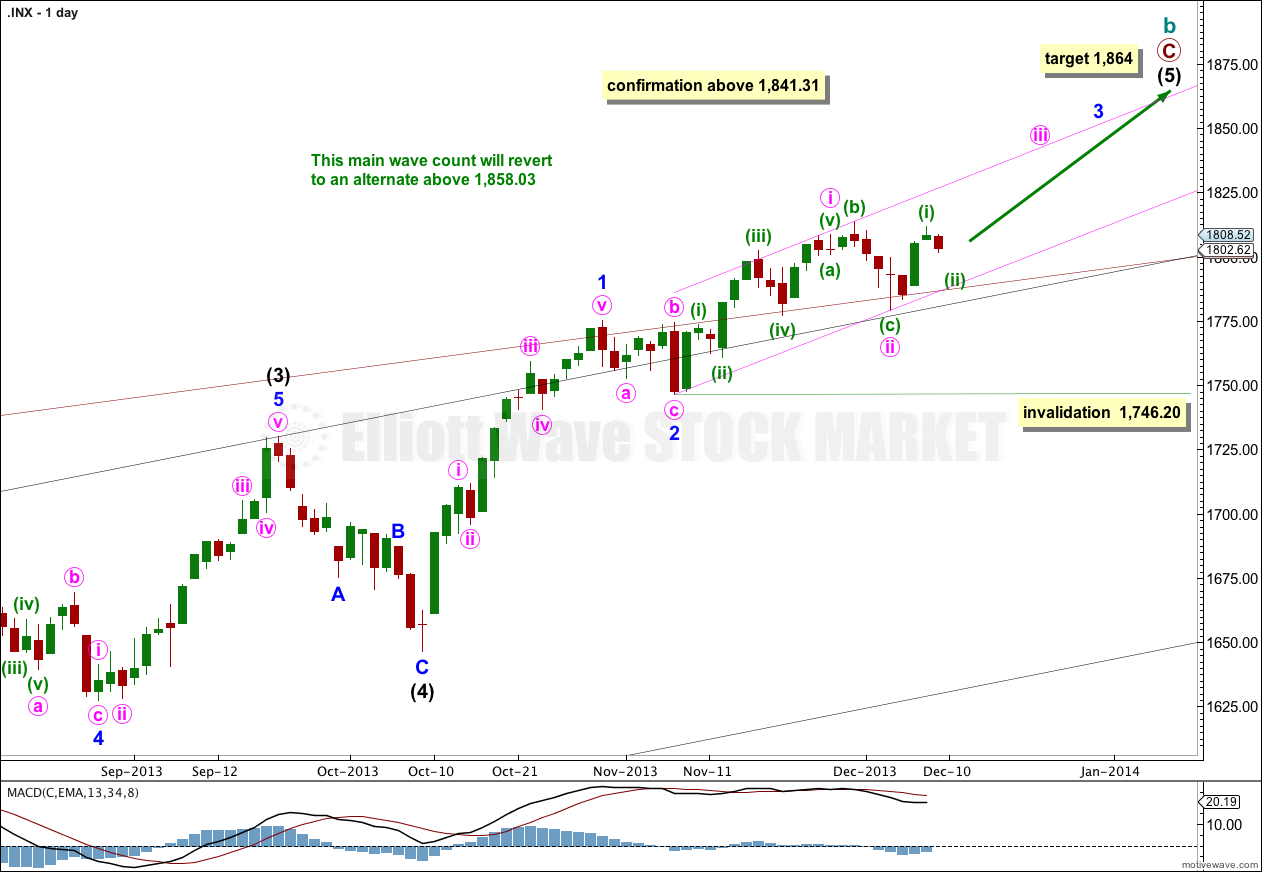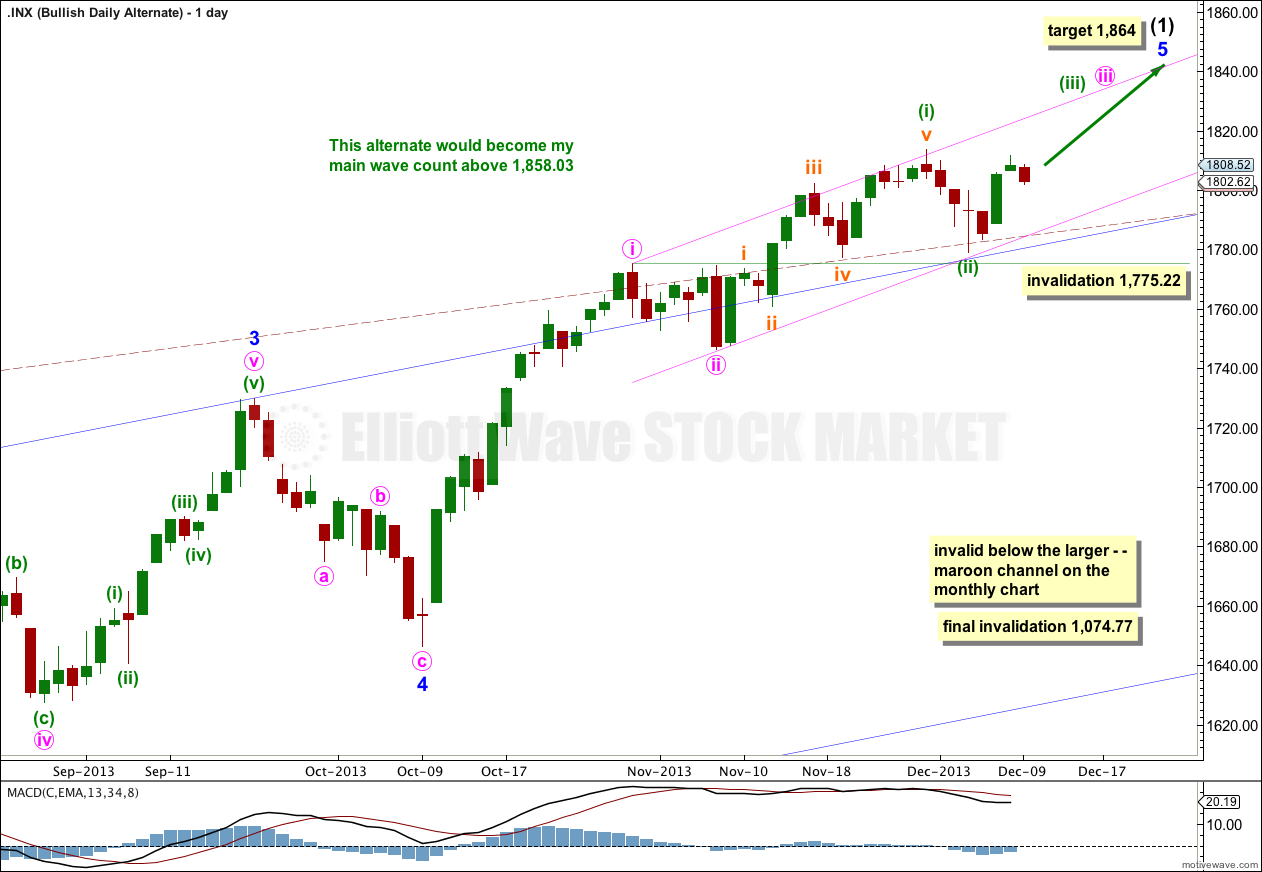Last analysis expected some downwards movement for a second wave correction, but I had expected it to be over more quickly so as to not see a red candlestick on the daily chart.
The wave count remains the same.
Click on the charts below to enlarge.
Main Wave Count.
This wave count has a higher probability than the alternate. Upwards movement over the last 4 1/2 years subdivides best as a zigzag. If something is “off” about the supposed recovery then it must be a B wave because there is plenty that is off in this scenario in terms of social mood.
Minor wave 3 may be finding support along the upper edge of the big maroon channel from the monthly chart, if the upper trend line is pushed out to encompass all of primary wave A.
Intermediate wave (5) is incomplete, with minor waves 1 and 2 complete.
Because momentum within minor wave 3 has not yet exceeded that of minor wave 1, minor wave 3 is probably incomplete.
Within minor wave 3 minute wave ii may not move beyond the start of minute wave i. This wave count is invalidated with movement below 1,746.20.
Draw an acceleration channel about minor wave 3. Draw the first trend line from the start of it to the end of minute wave ii within it. If the next upwards wave is minute wave iii within minor wave 3 then it should breach the upper edge of this channel.
Minor wave 1 lasted 15 days and is extended. Minor wave 3 may or may not be extended, because one or two actionary waves within an impulse may extend. As more of minor wave 3 unfolds I will calculate a target for it to end, which may be above 1,864 if minor wave 3 reaches equality with minor wave 1. That would be achieved at 1,875.
At 1,864 intermediate wave (5) would reach equality in length with intermediate wave (1). As more of intermediate wave (5) unfolds I will add to this target calculation at minor and eventually minute wave degrees, so it may change. For now I can only calculate the target at one wave degree.
At 1,858.03 cycle wave b would reach 138% the length of cycle wave a. At super cycle degree this wave count sees a large expanded flat unfolding. Within the expanded flat the maximum common length of cycle wave b is up to 138% the length of cycle wave a. When cycle wave b becomes longer than this then the probability that an expanded flat is unfolding decreases. At that stage I would swap over the main and alternate daily wave counts.
At 1,841 minute wave iii would reach equality in length with minute wave i. With the subdivisions within minute wave iii now showing on the daily chart it may be extending. The target may be too low. When minuette waves (iii) and (iv) within it are complete then I will add to the target calculation at a second wave degree.
Minuette wave (ii) is still incomplete and should move price lower again tomorrow. It looks like this correction may be unfolding as a zigzag. Within it subminuette waves a and b are complete. At 1,797 subminuette wave c would reach equality in length with subminuette wave a.
I have drawn a small channel about minuette wave (ii). I would expect downwards movement to most likely end at the lower edge of this channel. When the channel is breached by subsequent upwards movement that may be the first indication that minuette wave (iii) has begun.
Minuette wave (ii) may not move beyond the start of minuette wave (i). This wave count is invalidated with movement below 1,779.09.
Bullish Alternate Wave Count.
It is possible that a new cycle degree bull market began at 666.79. So far it is not yet halfway through, and I would expect it to last for a few years (at least five more years and probably longer).
At some stage then the current upwards impulse, labeled intermediate wave (5) for the main wave count and minor wave 5 for this alternate, will be completed. At that stage both wave counts would expect a trend change. The main wave count would expect a huge cycle degree trend change, and this alternate would expect an intermediate degree trend change. If the downwards movement subdivides as a three and remains within the maroon channel then this alternate would be preferred. If it breaches the channel this alternate would be discarded.
The maroon – – – channel is an acceleration channel drawn about primary waves 1 and 2 on the monthly chart (it is drawn in exactly the same way on the main wave count, but there it is termed a corrective channel). I would not expect intermediate wave (2) to breach this channel because a lower degree (intermediate) wave should not breach an acceleration channel of a higher degree (primary) first and second wave.
The daily chart shows the structure of minor wave 5. It is incomplete. Targets are the same because they are calculated using the same wave lengths as the main wave count. This bullish alternate does not diverge from the main wave count at this stage, and it will not for some weeks (or months) to come.



